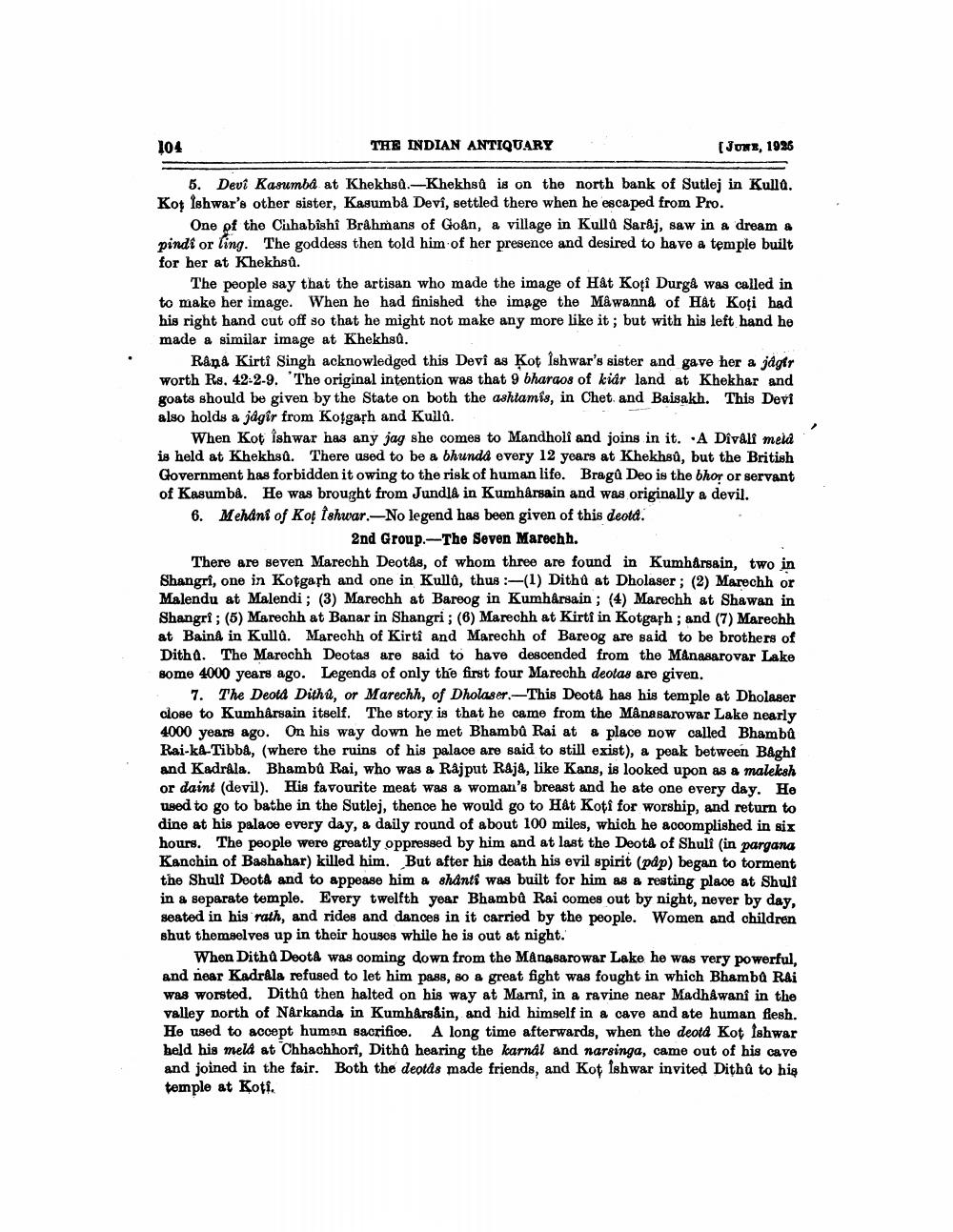________________
104
THE INDIAN ANTIQUARY
[Jon, 1926
5. Devi Kasumba at Khekhs0.-Khekhsů is on the north bank of Sutlej in Kulld. Kot Ishwar's other sister, Kagumba Devi, settled there when he escaped from Pro.
One of the Chhabishi Brahmans of Goán, a village in Kullu Saraj, saw in a dream & pindi or ling. The goddess then told him of her presence and desired to have a temple built for her at Khekhsú.
The people say that the artisan who made the image of Håt Koți Durg& was called in to make her image. When he had finished the image the Mâwanna of Hat Koti had his right hand cut off so that he might not make any more like it; but with his left hand he made a similar image at Khekhsů.
Rana Kirti Singh acknowledged this Devi as ķot Ishwar's sister and gave her a jagir worth Rs. 42-2-9. The original intention was that 9 bharaos of kidr land at Khekhar and goats should be given by the State on both the ashtamis, in Chet. and Baisakh. This Devi also holds a jdgir from Kotgaph and Kullû.
When Kot Ishwar has any jag she comes to Mandholi and joins in it. A Divali meld is held at Khekhsû. There used to be a bhunda every 12 years at Khekhsú, but the British Government has forbidden it owing to the risk of human life. Braga Deo is the bhor or servant of Kasumba. He was brought from Jundlå in Kumharsain and was originally a devil. 6. Mehani of Ko Ishwar.-No legend has been given of this deota.
2nd Group.--The Seven Marechh. There are seven Marechh Deotas, of whom three are found in Kumhårsain, two in Shangri, one in Kotgarh and one in Kulla, thus :-(1) Dithu at Dholaser; (2) Marechh or Malendu at Malendi; (3) Marechh at Baroog in Kumhårsain; (4) Marechh at Shawan in Shangri; (5) Marechh at Banar in Shangri; (6) Marechh at Kirti in Kotgarh ; and (7) Marechh at Baina in Kulla. Marechh of Kirti and Marechh of Bareog are said to be brothers of Ditha. The Marechh Deotas are said to have descended from the Managarovar Lake some 4000 years ago. Legends of only the first four Marechh deolas are given.
7. The Deotd Ditha, or Marechh, of Dholaser.-This Deota has his temple at Dholaser close to Kumharsain itself. The story is that he came from the Manasarowar Lake nearly 4000 years ago. On his way down he met Bhambů Rai at a place now called Bhambů Rai-ke-Tibba, (where the ruins of his palace are said to still exist), a peak between Baghi and Kadrála. Bhambů Rai, who was a Rajput Raja, like Kang, is looked upon as a maleksh or daint (devil). His favourite meat was a woman's breast and he ate one every day. He used to go to bathe in the Sutlej, thence he would go to Hat Koti for worship, and return to dine at his palace every day, a daily round of about 100 miles, which he accomplished in six hours. The people were greatly oppressed by him and at last the Deoth of Shuli (in pargana Kanchin of Bashahar) killed him. But after his death his evil spirit (pap) began to torment the Shuli Deota and to appease him a shanti was built for him as a resting place at Shuli in a separate temple. Every twelfth year Bhambů Rai comes out by night, never by day, seated in his rath, and rides and dances in it carried by the people. Women and children shut themselves up in their houses while he is out at night.
When Ditha Doota was coming down from the Mangsarowar Lake he was very powerful, and near Kadrála refused to let him pass, 80 a great fight was fought in which Bhamba Rai was worsted. Ditha then halted on his way at Marni, in a ravine near Madhwani in the valley Dorth of Narkanda in Kumharskin, and hid himself in a cave and ate human flesh. He used to accept human sacrifice. A long time afterwards, when the deotd Kot Ishwar held his meld at Chhachhori, Dithû hearing the karnal and narsinga, came out of his cave and joined in the fair. Both the deotás made friends, and Kot Ishwar invited Dithů to his temple at Koti.




